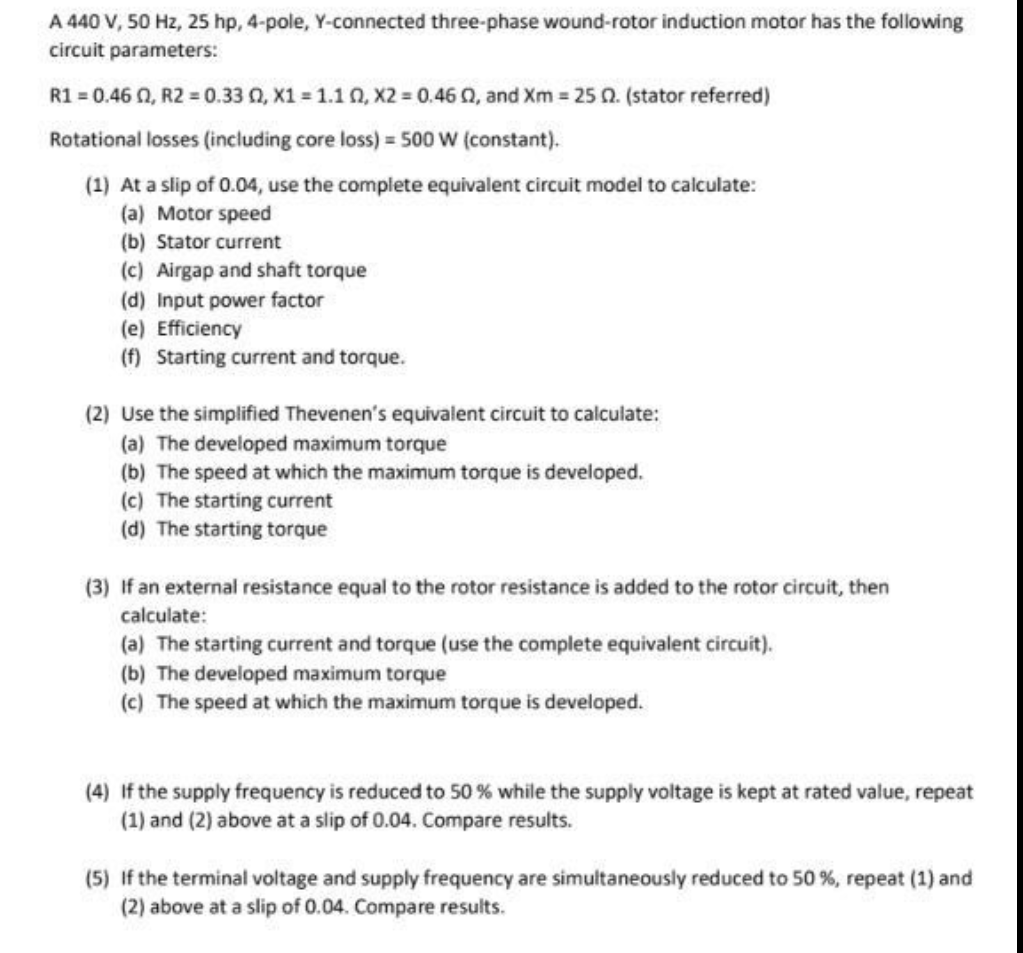A 440 V, 50 Hz, 25 hp, 4-pole, Y-connected three-phase wound-rotor induction motor has the following circuit parameters: R1 = 0.46 02, R2 = 0.33 0, x1 = 1.102, X2=0.46 02, and Xm = 25 02. (stator referred) Rotational losses (including core loss) = 500 W (constant). (1) At a slip of 0.04, use the complete equivalent circuit model to calculate: (a) Motor speed (b) Stator current (c) Airgap and shaft torque (d) Input power factor (e) Efficiency (f) Starting current and torque. (2) Use the simplified Thevenen's equivalent circuit to calculate: (a) The developed maximum torque (b) The speed at which the maximum torque is developed. (c) The starting current (d) The starting torque (3) If an external resistance equal to the rotor resistance is added to the rotor circuit, then calculate: (a) The starting current and torque (use the complete equivalent circuit). (b) The developed maximum torque (c) The speed at which the maximum torque is developed. (4) If the supply frequency is reduced to 50 % while the supply voltage is kept at rated value, repeat (1) and (2) above at a slip of 0.04. Compare results. (5) If the terminal voltage and supply frequency are simultaneously reduced to 50 %, repeat (1) and (2) above at a slip of 0.04. Compare results.
A 440 V, 50 Hz, 25 hp, 4-pole, Y-connected three-phase wound-rotor induction motor has the following circuit parameters: R1 = 0.46 02, R2 = 0.33 0, x1 = 1.102, X2=0.46 02, and Xm = 25 02. (stator referred) Rotational losses (including core loss) = 500 W (constant). (1) At a slip of 0.04, use the complete equivalent circuit model to calculate: (a) Motor speed (b) Stator current (c) Airgap and shaft torque (d) Input power factor (e) Efficiency (f) Starting current and torque. (2) Use the simplified Thevenen's equivalent circuit to calculate: (a) The developed maximum torque (b) The speed at which the maximum torque is developed. (c) The starting current (d) The starting torque (3) If an external resistance equal to the rotor resistance is added to the rotor circuit, then calculate: (a) The starting current and torque (use the complete equivalent circuit). (b) The developed maximum torque (c) The speed at which the maximum torque is developed. (4) If the supply frequency is reduced to 50 % while the supply voltage is kept at rated value, repeat (1) and (2) above at a slip of 0.04. Compare results. (5) If the terminal voltage and supply frequency are simultaneously reduced to 50 %, repeat (1) and (2) above at a slip of 0.04. Compare results.
Delmar's Standard Textbook Of Electricity
7th Edition
ISBN:9781337900348
Author:Stephen L. Herman
Publisher:Stephen L. Herman
Chapter33: Single-phase Motors
Section: Chapter Questions
Problem 17RQ
Related questions
Question
please solve question 5 and thanks alot sir

Transcribed Image Text:A 440 V, 50 Hz, 25 hp, 4-pole, Y-connected three-phase wound-rotor induction motor has the following
circuit parameters:
R1 = 0.46 02, R2 = 0.33 0, x1 = 1.102, X2=0.46 02, and Xm = 25 02. (stator referred)
Rotational losses (including core loss) = 500 W (constant).
(1) At a slip of 0.04, use the complete equivalent circuit model to calculate:
(a) Motor speed
(b) Stator current
(c) Airgap and shaft torque
(d) Input power factor
(e) Efficiency
(f) Starting current and torque.
(2) Use the simplified Thevenen's equivalent circuit to calculate:
(a) The developed maximum torque
(b) The speed at which the maximum torque is developed.
(c) The starting current
(d) The starting torque
(3) If an external resistance equal to the rotor resistance is added to the rotor circuit, then
calculate:
(a) The starting current and torque (use the complete equivalent circuit).
(b) The developed maximum torque
(c) The speed at which the maximum torque is developed.
(4) If the supply frequency is reduced to 50 % while the supply voltage is kept at rated value, repeat
(1) and (2) above at a slip of 0.04. Compare results.
(5) If the terminal voltage and supply frequency are simultaneously reduced to 50 %, repeat (1) and
(2) above at a slip of 0.04. Compare results.
Expert Solution
This question has been solved!
Explore an expertly crafted, step-by-step solution for a thorough understanding of key concepts.
Step by step
Solved in 4 steps with 3 images

Knowledge Booster
Learn more about
Need a deep-dive on the concept behind this application? Look no further. Learn more about this topic, electrical-engineering and related others by exploring similar questions and additional content below.Recommended textbooks for you

Delmar's Standard Textbook Of Electricity
Electrical Engineering
ISBN:
9781337900348
Author:
Stephen L. Herman
Publisher:
Cengage Learning

Delmar's Standard Textbook Of Electricity
Electrical Engineering
ISBN:
9781337900348
Author:
Stephen L. Herman
Publisher:
Cengage Learning